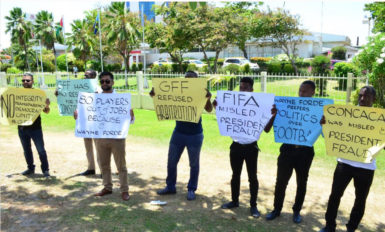
For many enthusiasts, players and administrators, the episode can be viewed as the largest acting production conducted in recent memory, deflecting the spotlight with the aid of heavily worded rhetoric, off of the present inadequacies.
While less than impactful, the five-member protest outside the FIFA Press Conference held at the Pegasus Hotel by members of the Georgetown Football Club (GFC), highlighted the fact that the football community is still fractured, even though the cause for public frustrations were political as the matter (Stag Beer Elite League non-participation fiasco) is already done and dusted ‘eons’ ago.

The aforesaid though, is just the tip of the iceberg and while conflict and criticism at and/or of the ruling administration will always occur, the programmes, policies and initiatives for the discipline’s advancement should continue.
With the simplest of definitions, football has to be played irrespective of the issues.
Presently that is not the case as the sport has been stagnant throughout the country at every level despite almost the first quarter of the year being concluded.
Football in the Georgetown Football Association (GFA), the GFF’s largest and often most tumultuous affiliate, is non-existent.
This diagnosis also applies to many of the other affiliates including the second largest affiliate, the Upper Demerara Football Association (UDFA), with non-traditional members including the Futsal Association, only active on paper and on the Internet.
Structured youth football at the club level is now a thing of the distant past with the lure of money that emanates from senior tournaments the attraction for many of the administrators at the helm of the various offices.
The GFF and its membership will point to the national NAMILCO U17 tournament as evidence of a structured youth programme.
However, to the best of one’s knowledge and many others, more than 60% of the respective zones are yet to complete their first round matches and where are the youth events that are supposed to be commissioned by the respective associations?
While the weather, an adversary of the many outdoor disciplines can be blamed for the lack of playing time, the NAMILCO event has failed to garner interest and at times seem to be treated as burdensome by the many involved in it’s respective ‘zonal administration’.
Referees and venues preparation are just two of the common struggles associated with the tournament although the proponents of the event will argue that it has expanded the national programme’s talent pool.
This, however, is not necessarily the case as many of the players who feature at this age group were either already on the national radar and/or were household names due their participation in other long standing championships.
Simply put, the event has been a failure. It will be interesting to witness the success of the Pele Alumni-sponsored Frank Watson Memorial U15 national tournament when it is implemented shortly.
The Academy Training Centre (ATC) is also a programme that comes in for criticism as while the concept must be lauded, its implementation has to be faulted.
How can anyone craft a programme that has a mandate of honing the skills of precocious U16 talents, when the majority of the respective clubs don’t have any structure in place to allow for the supposed seamless transition to the centres.
This could be considered as putting the cart before the horse.
Isn’t the development of youth players also a core mandate of every association?
The GFF has to ensure that every club is properly structured to foster the respective talents that may emanate so that the ATC’s input can be properly manifested.
Secondly, because of the absence of structure, the player selection process for this privileged programme can be partisan instead of logical in a fraternity that is never short of questionable practices.
The GFF Stag Beer Elite League is also not immune from critical assessment. Poor attendance, officiating, a fluctuating schedule and inconsistent quality has branded the league in a negative light. For some fans, it is playfully albeit painfully dubbed, the ‘Delete League’.
However the biggest issue surrounding the supposed ‘Highest Level’ locally is the nonpayment of the players. This saga is entering its fifth month and with no end in sight, severely hurts the credibility of the event and its administrators.
Although the GFF must be applauded for its attempts to restart the senior national programme and for placing emphasis on participation in international youth engagements, a large portion of the player pool is being marginalized due to their lack of inactivity.
From the inception of the Elite League by its engineers’ the Normalization Committee, a reserved league has to yet to be commissioned that caters for players outside of the respective Elite League roster.
While the current administration is not at fault for the birth of the problem, they are currently in the crosshairs because of the lack of a solution. Is the GFF saying that the players outside the Elite League rosters of the competing clubs are not important?
The importance of visits from FIFA dignitaries cannot be understated as they bring credibility and insight into the projects that are expected to be undertaken by the federation.
However these noteworthy events and the resulting information that emanates from the disclosures, should not serve as distractions for the issues at hand.




